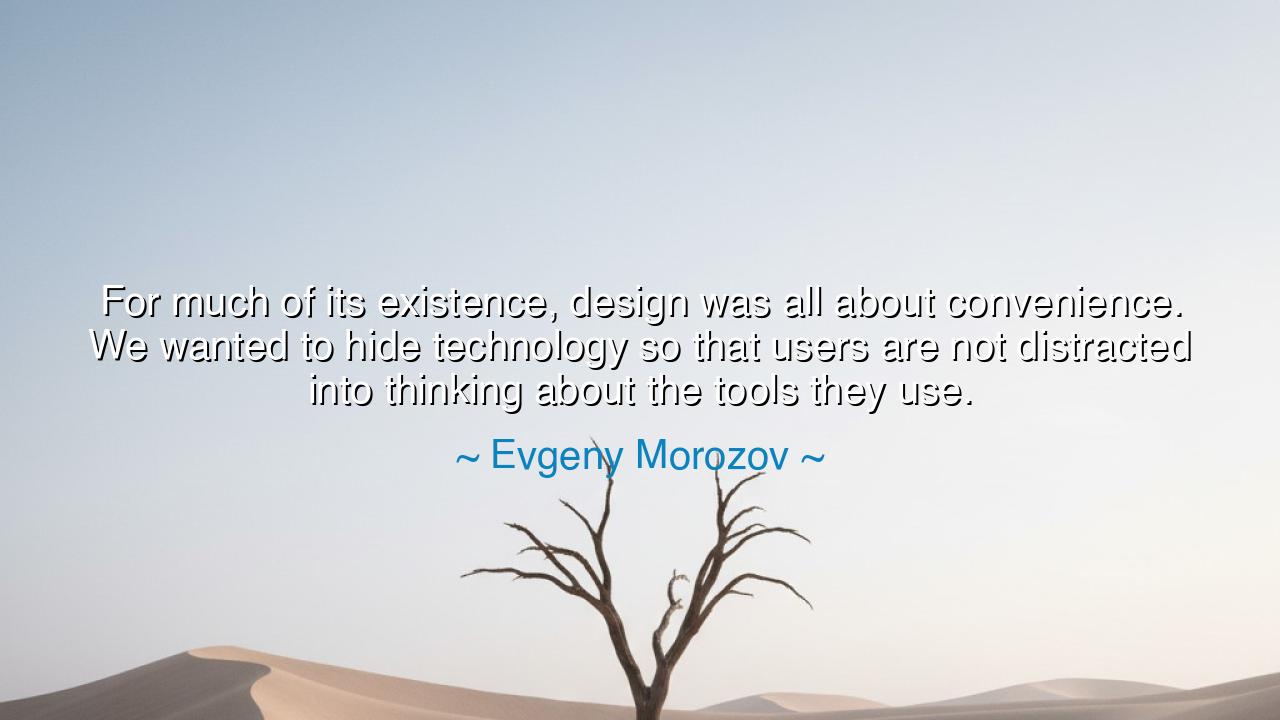
For much of its existence, design was all about convenience. We
For much of its existence, design was all about convenience. We wanted to hide technology so that users are not distracted into thinking about the tools they use.






“For much of its existence, design was all about convenience. We wanted to hide technology so that users are not distracted into thinking about the tools they use.” Thus spoke Evgeny Morozov, a philosopher of the digital age, whose eyes pierce through the glittering veil of innovation to uncover the deeper questions of our time. His words are not merely a reflection on design — they are a meditation on human awareness, on the strange paradox of progress: that the more we surround ourselves with technology, the less we seem to see it. In this truth lies both the triumph and the tragedy of modern creation.
From the earliest days of invention, humankind has sought to simplify life — to make tools that would ease the burden of labor, speed the hand, and sharpen the mind. Yet as Morozov reminds us, in our pursuit of convenience, we have also learned to conceal the very things that shape our world. Where once the craftsman’s hammer, the farmer’s plow, and the scholar’s ink revealed the noble partnership between human and tool, now our devices vanish behind glass screens and seamless surfaces. We have made the instruments invisible — not to enhance our awareness, but to escape it. For in hiding the tool, we also hide the thought, the labor, and the responsibility that birthed it.
The origin of this philosophy lies in the age of modern design, when architects, engineers, and artists sought to merge beauty with utility. The twentieth century brought forth the creed of “form follows function,” and soon, technology became not an object of wonder, but of quiet obedience. The Bauhaus masters, the apostles of minimalism, sought to strip the world of ornament, to let function reign supreme. And so, the modern age began to hide complexity behind simplicity. The machine was not to be admired, but to be invisible — a silent servant attending to human needs. The smoothness of a button, the elegance of a curve, the automation of thought itself — all were designed to make the user forget the machine’s existence.
Yet Morozov warns that this invisibility comes at a cost. When we cease to notice the tools we use, we cease to understand them — and when we no longer understand them, we surrender power. The ancients knew that mastery demanded awareness. The blacksmith who forged a sword knew its weight, its temper, its sound as it met the anvil. The scribe who carved words into clay understood the rhythm of each stroke. Their tools were not distractions; they were extensions of the self. But we, in our quest for convenience, have severed this bond. The phone in the pocket, the algorithm in the cloud — these now shape our lives in ways we cannot see and no longer question.
Consider the story of Steve Jobs, who revolutionized design by hiding complexity behind beauty. The devices he created at Apple were marvels of simplicity, designed to feel natural and intuitive, to make technology feel human. Yet, as history unfolded, that very brilliance birthed dependence. Users learned to love the surface, but forgot to look beneath it. We came to revere the ease of use but lost the curiosity to understand. In this way, the philosopher’s warning took shape: that a tool unseen becomes a master unknown. For what we cannot see, we cannot question — and what we cannot question, we cannot control.
Morozov’s words call us back to awareness, to the ancient discipline of being mindful of our creations. He urges us not to reject design, but to design differently — to let our tools be visible again, to invite reflection rather than concealment. For only when we recognize the presence of technology can we reclaim our relationship with it. The wise must not fear friction or complexity; they must see it as the texture of understanding. To be human is not to have everything made easy, but to grow through engagement, to know the things that serve us and how they do so.
So, my child, take this teaching to heart: do not drift in a world of invisible machinery. Seek to know the tools that shape your days — the devices, the systems, the designs that govern your life. Question their purpose, their origin, their cost to others and to the earth. For the pursuit of convenience without consciousness is a gentle enslavement, wrapped in comfort. Let your awareness be the lens through which you see the hidden architecture of your world. Use technology not as a veil, but as a mirror — one that reflects your creativity, not your complacency.
For in the end, the greatest design is not one that hides, but one that reveals — not one that numbs, but one that awakens. The wise do not seek ease; they seek understanding. And in understanding, they find a deeper kind of convenience: the harmony between mind and tool, between maker and made. Thus, remember Morozov’s words as both a warning and a call — that in an age where everything is designed to disappear, it is the duty of the thoughtful soul to see.






AAdministratorAdministrator
Welcome, honored guests. Please leave a comment, we will respond soon